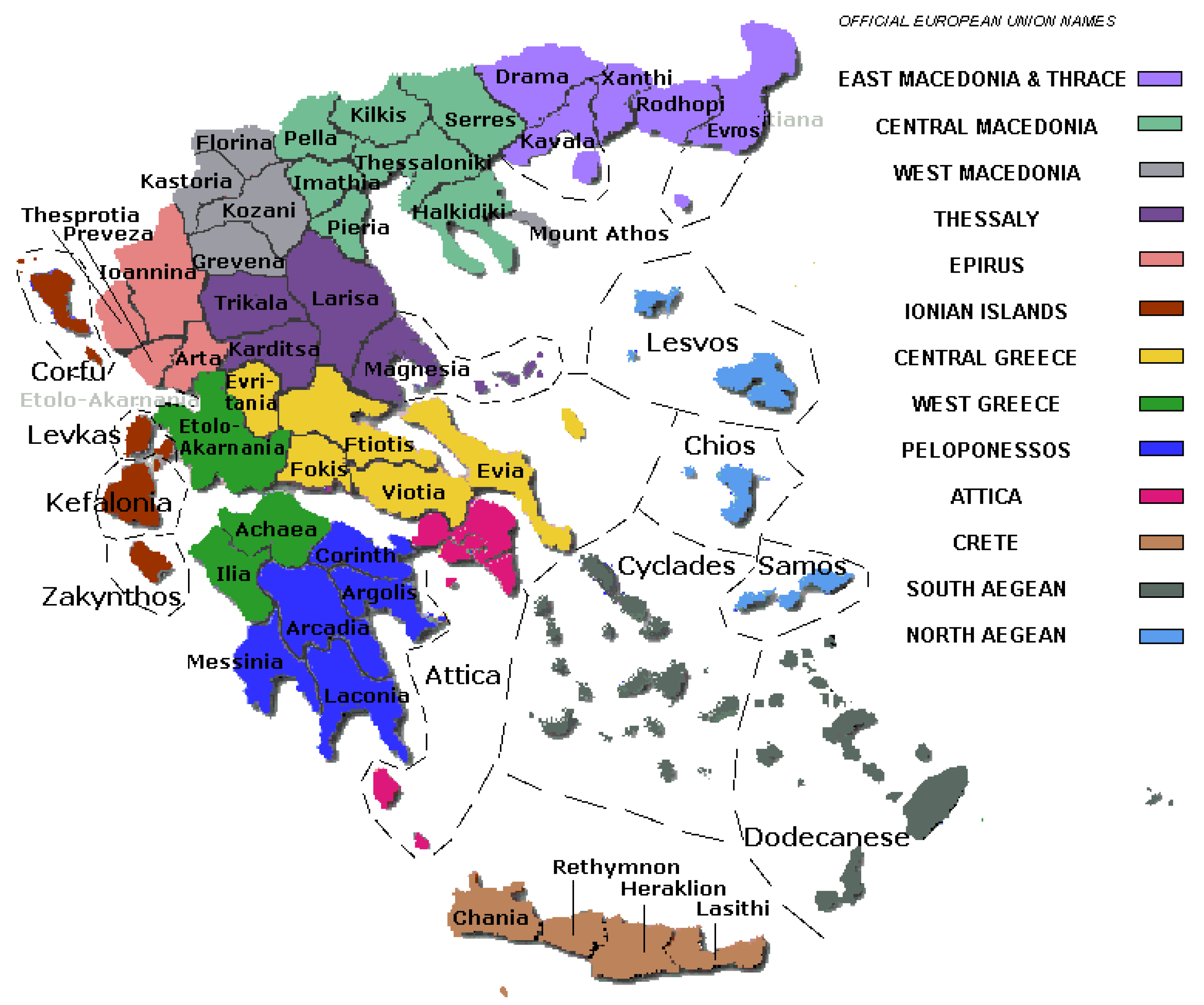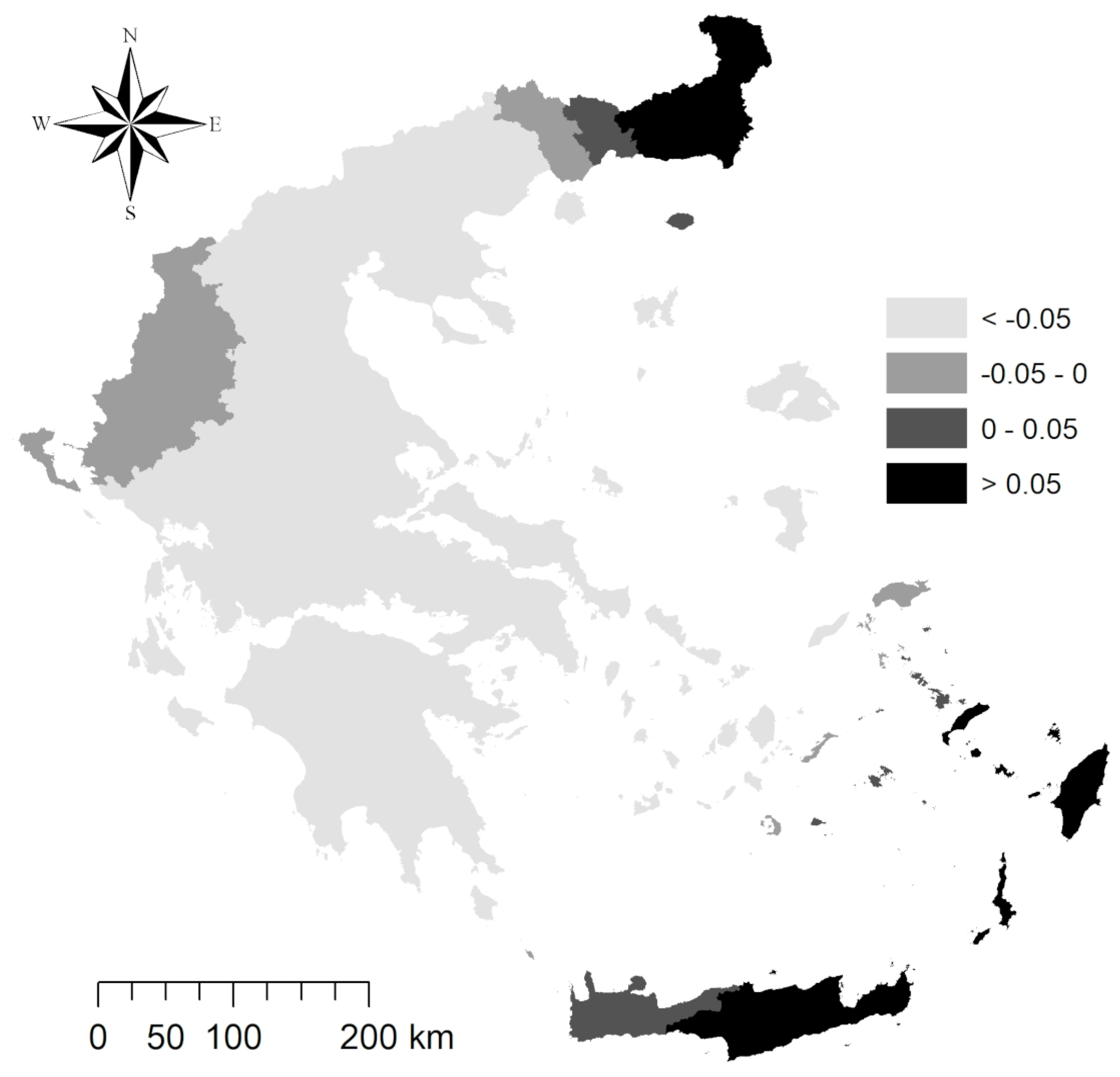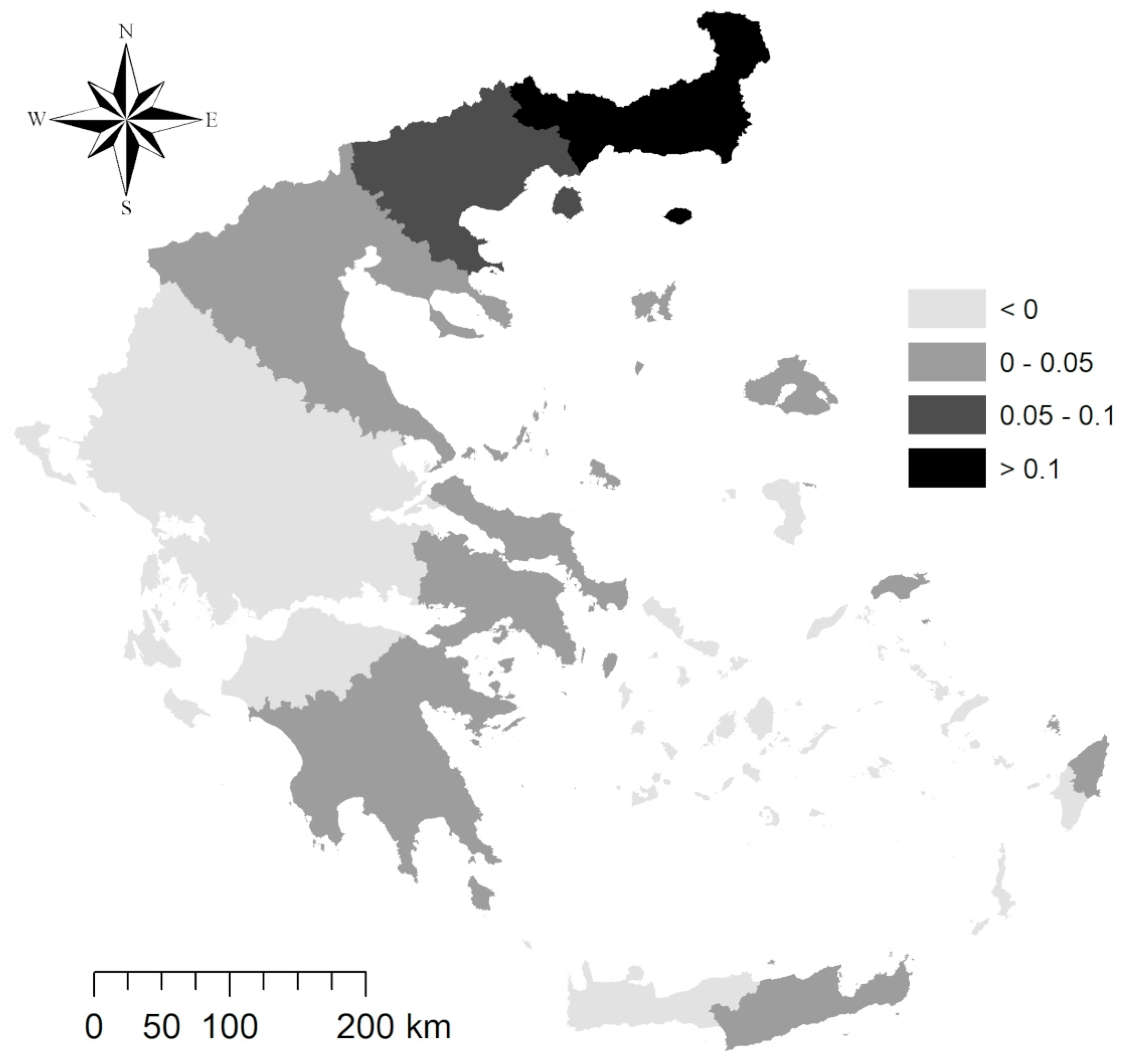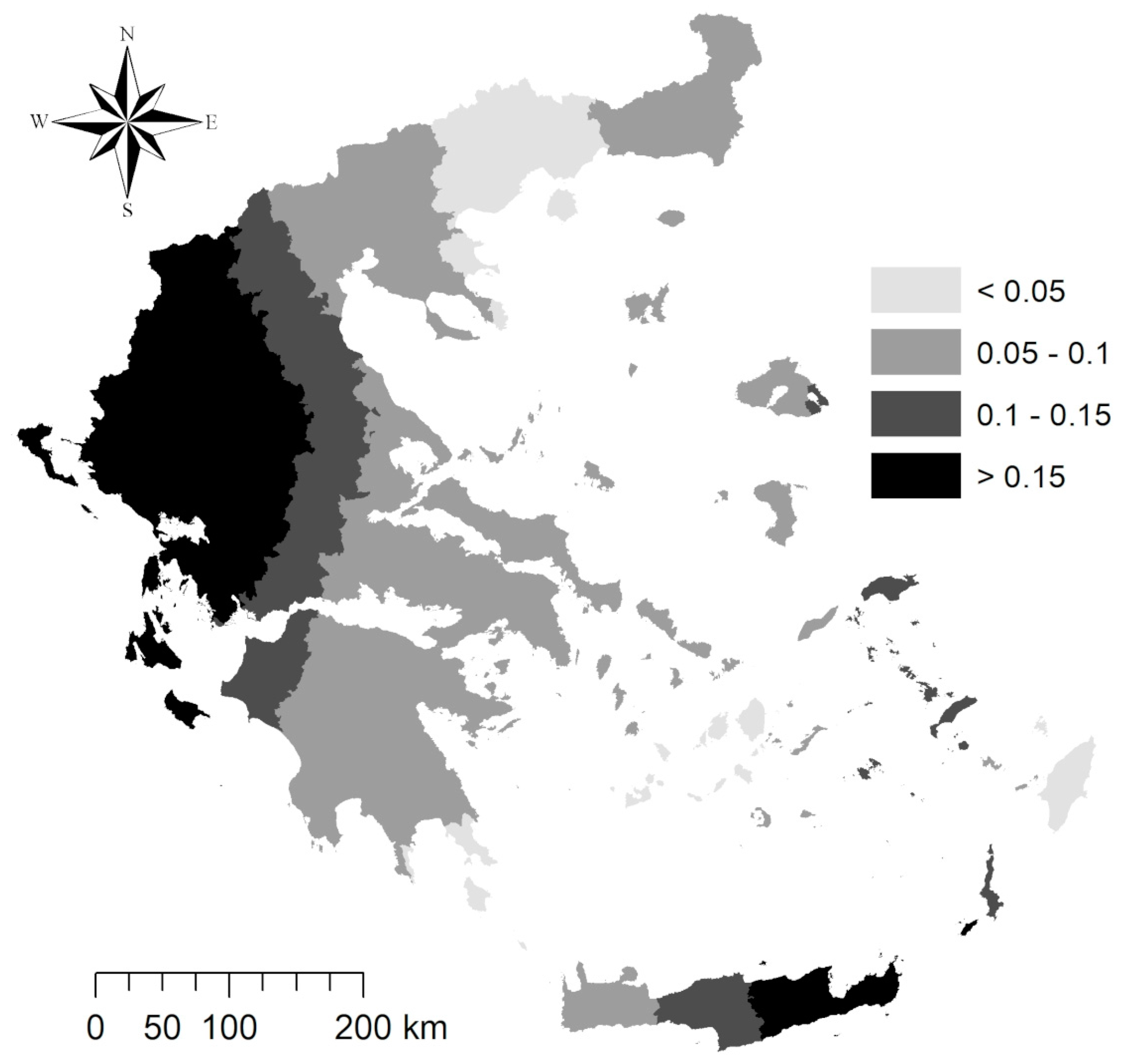Population Trends and Urbanization: Simulating Density Effects Using a Local Regression Approach
Abstract
:1. Introduction
Density-Dependent Mechanisms of Population Growth in Europe
2. Methodology
2.1. Study Area
2.2. Data Sources and Demographic Variables
2.3. Statistical Analysis
3. Results
3.1. Analysis of Spatial Auto-Correlation Regimes of Population Growth
3.2. Local Regression Analysis
4. Discussion
5. Conclusions
Author Contributions
Funding
Conflicts of Interest
References
- Combes, P.P.; Duranton, G.; Overman, H.G. Agglomeration and the adjustment of the spatial economy. Pap. Reg. Sci. 2005, 84, 311–349. [Google Scholar] [CrossRef]
- Gardiner, B.; Martin, R.; Tyler, P. Does spatial agglomeration increase national growth? Some evidence from Europe. J. Econ. Geogr. 2011, 11, 979–1006. [Google Scholar] [CrossRef] [Green Version]
- Haase, A.; Bernt, M.; Großmann, K.; Mykhnenko, V.; Rink, D. Varieties of shrinkage in European cities. Eur. Urban Reg. Stud. 2016, 23, 86–102. [Google Scholar] [CrossRef]
- Tóth, G.; Nagy, Z. The world’s economic centre of gravity. Reg. Stat. 2016, 6, 177–180. [Google Scholar]
- Petrakos, G.C. Urban Concentration and Agglomeration Economies: Re-examining the Relationship. Urban Stud. 1992. [Google Scholar] [CrossRef]
- Turok, I. Cities, Regions and Competitiveness. Reg. Stud. 2004, 38, 1069–1083. [Google Scholar] [CrossRef]
- Combes, P.-P.; Duranton, G.; Gobillon, L. The identification of agglomeration economies. J. Econ. Geogr. 2011, 11, 253–266. [Google Scholar] [CrossRef] [Green Version]
- Munafò, M.; Salvati, L.; Zitti, M. Estimating soil sealing rate at national level—Italy as a case study. Ecol. Indic. 2013, 26, 137–140. [Google Scholar] [CrossRef]
- Gavalas, V.S.; Rontos, K.; Salvati, L. Who Becomes an Unwed Mother in Greece? Sociodemographic and Geographical Aspects of an Emerging Phenomenon. Popul. Space Place 2014, 20, 250–263. [Google Scholar] [CrossRef]
- Morelli, V.G.; Rontos, K.; Salvati, L. Between suburbanisation and re-urbanisation: Revisiting the urban life cycle in a Mediterranean compact city. Urban Res. Pract. 2014, 7, 74–88. [Google Scholar] [CrossRef]
- Russo, A.P.; Giné, D.S.; Albert, M.Y.P.; Brandajs, F. Identifying and Classifying Small and Medium Sized Towns in Europe. Tijdschr. Econ. Soc. Geogr. 2017, 108, 380–402. [Google Scholar] [CrossRef]
- Melo, P.C.; Graham, D.J.; Noland, R.B. A meta-analysis of estimates of urban agglomeration economies. Reg. Sci. Urban Econ. 2009, 39, 332–342. [Google Scholar] [CrossRef] [Green Version]
- Solon, J. Spatial context of urbanization: Landscape pattern and changes between 1950 and 1990 in the Warsaw metropolitan area, Poland. Landsc. Urban Plan. 2009, 93, 250–261. [Google Scholar] [CrossRef] [Green Version]
- Salvati, L. Agro-forest landscape and the ‘fringe’ city: A multivariate assessment of land-use changes in a sprawling region and implications for planning. Sci. Total Environ. 2014, 490, 715–723. [Google Scholar] [CrossRef]
- Serra, P.; Vera, A.; Tulla, A.F.; Salvati, L. Beyond urban–rural dichotomy: Exploring socioeconomic and land-use processes of change in Spain (1991–2011). Appl. Geogr. 2014, 55, 71–81. [Google Scholar] [CrossRef]
- Weilenmann, B.; Seidl, I.; Schulz, T. The socio-economic determinants of urban sprawl between 1980 and 2010 in Switzerland. Landsc. Urban Plan. 2017, 157, 468–482. [Google Scholar] [CrossRef]
- Relethford, J.H. Density-dependent migration and human population structure in historical Massachusetts. Am. J. Phys. Anthropol. 1986, 69, 377–388. [Google Scholar] [CrossRef]
- Delacroix, J.; Swaminathan, A.; Solt, M.E. Density Dependence Versus Population Dynamics: An Ecological Study of Failings in the California Wine Industry. Am. Sociol. Rev. 1989, 54, 245. [Google Scholar] [CrossRef]
- Bauch, C.T. Wealth as a source of density dependence in human population growth. Oikos 2008, 117, 1824–1832. [Google Scholar] [CrossRef] [Green Version]
- Lee, R.D. Population dynamics of humans and other animals. Demography 1987, 24, 443–465. [Google Scholar] [CrossRef]
- Fowler, C.W. Density Dependence as Related to Life History Strategy. Ecology 1981, 62, 602–610. [Google Scholar] [CrossRef]
- Turchin, P. Rarity of density dependence or population regulation with lags? Nature 1990, 344, 660–663. [Google Scholar] [CrossRef]
- Hopfenberg, R. Human Carrying Capacity Is Determined by Food Availability. Popul. Environ. 2003, 25, 109–117. [Google Scholar] [CrossRef]
- Berryman, A.A. Principles of Population Dynamics and Their Application; Stanley Thornes: Cheltenham, UK, 1999; ISBN 978-0-7487-4015-4. [Google Scholar]
- Cohen, J.E. Human population: The next half century. Science 2003, 302, 1172–1175. [Google Scholar] [CrossRef]
- Lima, M.; Berryman, A.A. Positive and negative feedbacks in human population dynamics: Future equilibrium or collapse? Oikos 2011, 120, 1301–1310. [Google Scholar] [CrossRef]
- Ostffeld, R.S.; Canham, C.D.; Pugh, S.R. Intrinsic density-dependent regulation of vole populations. Nature 1993, 366, 259–261. [Google Scholar] [CrossRef] [PubMed]
- Mueller, L.D.; Guo, P.Z.; Ayala, F.J. Density-dependent natural selection and trade-offs in life history traits. Science 1991, 253, 433–435. [Google Scholar] [CrossRef] [PubMed] [Green Version]
- Åström, M.; Lundberg, P.; Lundberg, S. Population Dynamics with Sequential Density-Dependencies. Oikos 1996, 75, 174–181. [Google Scholar] [CrossRef]
- Waters, J.M.; Fraser, C.I.; Hewitt, G.M. Founder takes all: Density-dependent processes structure biodiversity. Trends Ecol. Evol. 2013, 28, 78–85. [Google Scholar] [CrossRef]
- Berry, B.J.L. City Size Distributions and Economic Development. Econ. Dev. Cult. Chang. 1961, 9, 573–588. [Google Scholar]
- Sibly, R.M.; Hone, J.; Clutton-Brock, T.H. Population growth rate: Determining factors and role in population regulation. Introduction. Philos. Trans. R. Soc. Lond. B Biol. Sci. 2002, 357, 1149–1151. [Google Scholar] [CrossRef] [Green Version]
- Metcalf, C.J.E.; Pavard, S. Why evolutionary biologists should be demographers. Trends Ecol. Evol. 2007, 22, 205–212. [Google Scholar] [CrossRef] [PubMed]
- Baker, J.; Ruan, X.; Alcantara, A.; Jones, T.; Watkins, K.; McDaniel, M.; Frey, M.; Crouse, N.; Rajbhandari, R.; Morehouse, J.; et al. Density-dependence in urban housing unit growth: An evaluation of the Pearl-Reed model for predicting housing unit stock at the census tract level. J. Econ. Soc. Meas. 2008, 33, 155–163. [Google Scholar] [CrossRef]
- Sibly, R.M.; Hone, J. Population growth rate and its determinants: An overview. Philos. Trans. R. Soc. Lond. B 2002, 357, 1153–1170. [Google Scholar] [CrossRef]
- Herrando-Pérez, S.; Delean, S.; Brook, B.W.; Bradshaw, C.J.A. Density dependence: An ecological Tower of Babel. Oecologia 2012, 170, 585–603. [Google Scholar] [CrossRef] [PubMed]
- Beeson, P.E.; DeJong, D.N.; Troesken, W. Population growth in U.S. counties, 1840–1990. Reg. Sci. Urban Econ. 2001, 31, 669–699. [Google Scholar] [CrossRef] [Green Version]
- Berliant, M.; Wang, P. Dynamic Urban Models: Agglomeration and Growth. In Contributions to Economic Analysis; Elsevier: Amsterdam, The Netherlands, 2004; Volume 266, pp. 531–581. ISBN 978-0-444-51481-3. [Google Scholar]
- Parvinen, K.; Dieckmann, U.; Gyllenberg, M.; Metz, J.A.J. Evolution of dispersal in metapopulations with local density dependence and demographic stochasticity. J. Evol. Biol. 2003, 16, 143–153. [Google Scholar] [CrossRef] [Green Version]
- Kincses, Á.; Nagy, Z.; Tóth, G. Modelling the spatial structure of Europe. Reg. Stat. 2014, 4, 40–54. [Google Scholar] [CrossRef]
- Beale, C.L. Rural depopulation in the united states: Some demographic consequences of agricultural adjustments. Demography 1964, 1, 264–272. [Google Scholar] [CrossRef]
- André, M.F. Depopulation, Land-use Change and Landscape Transformation in the French Massif Central. AMBIO 1998, 27, 351–353. [Google Scholar]
- Hoggart, K.; Paniagua, A. The restructuring of rural Spain? J. Rural Stud. 2001, 17, 63–80. [Google Scholar] [CrossRef]
- van Wissen, L. A Spatial Interpretation of the Density Dependence Model in Industrial Demography. Small Bus. Econ. 2004, 22, 253–264. [Google Scholar] [CrossRef]
- Alados, C.L.; Errea, P.; Gartzia, M.; Saiz, H.; Escós, J. Positive and Negative Feedbacks and Free-Scale Pattern Distribution in Rural-Population Dynamics. PLoS ONE 2014, 9, e114561. [Google Scholar] [CrossRef] [PubMed] [Green Version]
- Sale, P.F.; Tolimieri, N. Density dependence at some time and place? Oecologia 2000, 124, 166–171. [Google Scholar] [CrossRef]
- Hamilton, M.J.; Burger, O.; DeLong, J.P.; Walker, R.S.; Moses, M.E.; Brown, J.H. Population stability, cooperation, and the invasibility of the human species. Proc. Natl. Acad. Sci. USA 2009, 106, 12255–12260. [Google Scholar] [CrossRef] [Green Version]
- Caswell, H. Perturbation analysis of nonlinear matrix population models. Demogr. Res. 2008, 18, 59–116. [Google Scholar] [CrossRef] [Green Version]
- Salvati, L.; Serra, P. Estimating Rapidity of Change in Complex Urban Systems: A Multidimensional, Local-Scale Approach. Geogr. Anal. 2016, 48, 132–156. [Google Scholar] [CrossRef]
- Galor, O.; Weil, D.N. From Malthusian Stagnation to Modern Growth. Am. Econ. Rev. 1999, 89, 150–154. [Google Scholar] [CrossRef] [Green Version]
- Bosker, M. Growth, Agglomeration and Convergence: A Space-time Analysis for European Regions. Spat. Econ. Anal. 2007, 2, 91–100. [Google Scholar] [CrossRef]
- Baldini, R. The Importance of Population Growth and Regulation in Human Life History Evolution. PLoS ONE 2015, 10, e0119789. [Google Scholar] [CrossRef]
- Lemelin, A.; Rubiera-Morollón, F.; Gómez-Loscos, A. Measuring Urban Agglomeration: A Refoundation of the Mean City-Population Size Index. Soc. Indic. Res. 2016, 125, 589–612. [Google Scholar] [CrossRef]
- Cohen, J.E. Population growth and earth’s human carrying capacity. Science 1995, 269, 341–346. [Google Scholar] [CrossRef] [PubMed] [Green Version]
- Strulik, H. Learning-by-doing, population pressure, and the theory of demographic transition. J. Popul. Econ. 1997, 10, 285–298. [Google Scholar] [CrossRef]
- Rodríguez-Pose, A.; Fratesi, U. Between Development and Social Policies: The Impact of European Structural Funds in Objective 1 Regions. Reg. Stud. 2004, 38, 97–113. [Google Scholar] [CrossRef]
- Salvati, L.; Carlucci, M. The economic and environmental performances of rural districts in Italy: Are competitiveness and sustainability compatible targets? Ecol. Econ. 2011, 70, 2446–2453. [Google Scholar] [CrossRef]
- Zitti, M.; Ferrara, C.; Perini, L.; Carlucci, M.; Salvati, L. Long-Term Urban Growth and Land Use Efficiency in Southern Europe: Implications for Sustainable Land Management. Sustainability 2015, 7, 3359–3385. [Google Scholar] [CrossRef] [Green Version]
- Varga, L.; Tóth, G.; Néda, Z. An improved radiation model and its applicability for understanding commuting patterns in Hungary. Reg. Stat. 2016, 6, 27–38. [Google Scholar] [CrossRef] [Green Version]
- Zambon, I.; Serra, P.; Sauri, D.; Carlucci, M.; Salvati, L. Beyond the ‘Mediterranean city’: Socioeconomic disparities and urban sprawl in three Southern European cities. Geogr. Ann. Ser. B Hum. Geogr. 2017, 99, 319–337. [Google Scholar] [CrossRef]
- Oueslati, W.; Alvanides, S.; Garrod, G. Determinants of urban sprawl in European cities. Urban Stud. 2015. [Google Scholar] [CrossRef] [Green Version]
- Partridge, M.D.; Rickman, D.S.; Ali, K.; Olfert, M.R. Do New Economic Geography agglomeration shadows underlie current population dynamics across the urban hierarchy? Pap. Reg. Sci. 2009, 88, 445–466. [Google Scholar] [CrossRef]
- Portnov, B.A.; Schwartz, M. Urban Clusters as Growth Foci. J. Reg. Sci. 2009, 49, 287–310. [Google Scholar] [CrossRef]
- Salvati, L.; Gemmiti, R.; Perini, L. Land degradation in Mediterranean urban areas: An unexplored link with planning? Area 2012, 44, 317–325. [Google Scholar] [CrossRef]
- Kabisch, N.; Haase, D. Diversifying European agglomerations: Evidence of urban population trends for the 21st century. Popul. Space Place 2011, 17, 236–253. [Google Scholar] [CrossRef]
- Crescenzi, R.; Luca, D.; Milio, S. The geography of the economic crisis in Europe: National macroeconomic conditions, regional structural factors and short-term economic performance. Camb. J Reg. Econ. Soc. 2016, 9, 13–32. [Google Scholar] [CrossRef]
- Lauf, S.; Haase, D.; Kleinschmit, B. The effects of growth, shrinkage, population aging and preference shifts on urban development—A spatial scenario analysis of Berlin, Germany. Land Use Policy 2016, 52, 240–254. [Google Scholar] [CrossRef]
- Duvernoy, I.; Zambon, I.; Sateriano, A.; Salvati, L. Pictures from the other side of the fringe: Urban growth and peri-urban agriculture in a post-industrial city (Toulouse, France). J. Rural Stud. 2018, 57, 25–35. [Google Scholar] [CrossRef]
- Tapia, F.J.B.; Díez-Minguela, A.; Martinez-Galarraga, J. Tracing the Evolution of Agglomeration Economies: Spain, 1860–1991. J. Econ. Hist. 2018, 78, 81–117. [Google Scholar] [CrossRef] [Green Version]
- Kiochos, P.; Rontos, K. Urbanization and Large Cities in the Mediterranean Countries. Arch. Econ. Hist. 1999, 10, 1–2. [Google Scholar]
- Mykhnenko, V.; Turok, I. East European Cities—Patterns of Growth and Decline, 1960–2005. Int. Plan. Stud. 2008, 13, 311–342. [Google Scholar] [CrossRef]
- Paulsen, K. Geography, policy or market? New evidence on the measurement and causes of sprawl (and infill) in US metropolitan regions. Urban Stud. 2014, 51, 2629–2645. [Google Scholar] [CrossRef]
- Rickman, D.S.; Wang, H. US regional population growth 2000–2010: Natural amenities or urban agglomeration? Pap. Reg. Sci. 2017, 96, S69–S90. [Google Scholar] [CrossRef] [Green Version]
- Petrakos, G.; Rodríguez-Pose, A.; Rovolis, A. Growth, Integration, and Regional Disparities in the European Union. Environ. Plan. A 2016. [Google Scholar] [CrossRef]
- Di Feliciantonio, C.; Salvati, L. ‘Southern’ Alternatives of Urban Diffusion: Investigating Settlement Characteristics and Socio-Economic Patterns in Three Mediterranean Regions. Tijdschr. Econ. Soc. Geogr. 2015, 106, 453–470. [Google Scholar] [CrossRef]
- De Rosa, S.; Salvati, L. Beyond a ‘side street story’?Naples from spontaneous centrality to entropic polycentricism, towards a ‘crisis city’. Cities 2016, 51, 74–83. [Google Scholar] [CrossRef]
- Cuadrado-Ciuraneta, S.; Durà-Guimerà, A.; Salvati, L. Not only tourism: Unravelling suburbanization, second-home expansion and “rural” sprawl in Catalonia, Spain. Urban Geogr. 2017, 38, 66–89. [Google Scholar] [CrossRef]
- Kasanko, M.; Barredo, J.I.; Lavalle, C.; McCormick, N.; Demicheli, L.; Sagris, V.; Brezger, A. Are European cities becoming dispersed? A comparative analysis of 15 European urban areas. Landsc. Urban Plan. 2006, 77, 111–130. [Google Scholar] [CrossRef]
- Grekousis, G.; Manetos, P.; Photis, Y.N. Modeling urban evolution using neural networks, fuzzy logic and GIS: The case of the Athens metropolitan area. Cities 2013, 30, 193–203. [Google Scholar] [CrossRef]
- Colantoni, A.; Grigoriadis, E.; Sateriano, A.; Venanzoni, G.; Salvati, L. Cities as selective land predators? A lesson on urban growth, deregulated planning and sprawl containment. Sci. Total Environ. 2016, 545–546, 329–339. [Google Scholar] [CrossRef]
- Cecchini, M.; Zambon, I.; Pontrandolfi, A.; Turco, R.; Colantoni, A.; Mavrakis, A.; Salvati, L. Urban sprawl and the ‘olive’ landscape: Sustainable land management for ‘crisis’ cities. GeoJournal 2019, 84, 237–255. [Google Scholar] [CrossRef]
- Pili, S.; Grigoriadis, E.; Carlucci, M.; Clemente, M.; Salvati, L. Towards sustainable growth? A multi-criteria assessment of (changing) urban forms. Ecol. Indic. 2017, 76, 71–80. [Google Scholar] [CrossRef]
- Schneider, A.; Woodcock, C.E. Compact, Dispersed, Fragmented, Extensive? A Comparison of Urban Growth in Twenty-five Global Cities using Remotely Sensed Data, Pattern Metrics and Census Information. Urban Stud. 2008. [Google Scholar] [CrossRef]
- Carlucci, M.; Grigoriadis, E.; Rontos, K.; Salvati, L. Revisiting a Hegemonic Concept: Long-term ‘Mediterranean Urbanization’ in Between City Re-polarization and Metropolitan Decline. Appl. Spat. Anal. 2017, 10, 347–362. [Google Scholar] [CrossRef]
- Price, D. Carrying Capacity Reconsidered. Popul. Environ. 1999, 21, 5–26. [Google Scholar] [CrossRef]
- Lutz, W.; Sanderson, W.; Scherbov, S. The end of world population growth. Nature 2001, 412, 543–545. [Google Scholar] [CrossRef] [Green Version]
- Lutz, W.; Qiang, R. Determinants of human population growth. Philos. Trans. R. Soc. Lond. B Biol. Sci. 2002, 357, 1197–1210. [Google Scholar] [CrossRef] [PubMed]
- Sato, Y.; Yamamoto, K. Population concentration, urbanization, and demographic transition. J. Urban Econ. 2005, 58, 45–61. [Google Scholar] [CrossRef]
- Klasen, S.; Nestmann, T. Population, population density and technological change. J. Popul. Econ. 2006, 19, 611–626. [Google Scholar] [CrossRef] [Green Version]
- Frick, S.A.; Rodríguez-Pose, A. Change in urban concentration and economic growth. World Dev. 2018, 105, 156–170. [Google Scholar] [CrossRef]
- Ceccarelli, T.; Bajocco, S.; Luigi Perini, L.; Luca Salvati, L. Urbanisation and Land Take of High Quality Agricultural Soils—Exploring Long-term Land Use Changes and Land Capability in Northern Italy. Int. J. Environ. Res. 2014, 8, 181–192. [Google Scholar] [CrossRef]
- Giannakourou, G. Transforming spatial planning policy in Mediterranean countries: Europeanization and domestic change. Eur. Plan. Stud. 2005, 13, 319–331. [Google Scholar] [CrossRef]
- Halbac-Cotoara-Zamfir, R.; Egidi, G.; Mosconi, E.M.; Poponi, S.; Alhuseen, A.; Salvati, L. Uncovering Demographic Trends and Recent Urban Expansion in Metropolitan Regions: A Paradigmatic Case Study. Sustainability 2020, 12, 3937. [Google Scholar] [CrossRef]
- Ciommi, M.; Egidi, G.; Salvia, R.; Cividino, S.; Rontos, K.; Salvati, L. Population Dynamics and Agglomeration Factors: A Non-Linear Threshold Estimation of Density Effects. Sustainability 2020, 12, 2257. [Google Scholar] [CrossRef] [Green Version]
- Zambon, I.; Rontos, K.; Serra, P.; Colantoni, A.; Salvati, L. Population Dynamics in Southern Europe: A Local-Scale Analysis, 1961–2011. Sustainability 2019, 11, 109. [Google Scholar] [CrossRef] [Green Version]
- Salvati, L.; Sateriano, A.; Grigoriadis, E. Crisis and the city: Profiling urban growth under economic expansion and stagnation. Lett. Spat. Resour. Sci. 2016, 9, 329–342. [Google Scholar] [CrossRef]
- Ali, K.; Partridge, M.D.; Olfert, M.R. Can Geographically Weighted Regressions Improve Regional Analysis and Policy Making? Int. Reg. Sci. Rev. 2016. [Google Scholar] [CrossRef]
- Rontos, K.; Grigoriadis, E.; Sateriano, A.; Syrmali, M.; Vavouras, I.; Salvati, L. Lost in protest, found in segregation: Divided cities in the light of the 2015 “Oχι” referendum in Greece. City Cult. Soc. 2016, 7, 139–148. [Google Scholar] [CrossRef]
- Biasi, R.; Colantoni, A.; Ferrara, C.; Ranalli, F.; Salvati, L. In-between sprawl and fires: Long-term forest expansion and settlement dynamics at the wildland–urban interface in Rome, Italy. Int. J. Sustain. Dev. World Ecol. 2015, 22, 467–475. [Google Scholar] [CrossRef]
- Kazemzadeh-Zow, A.; Shahraki, S.Z.; Salvati, L.; Samani, N.N. A spatial zoning approach to calibrate and validate urban growth models. Int. J. Geogr. Inf. Sci. 2017, 31, 763–782. [Google Scholar] [CrossRef]
- Grafeneder-Weissteiner, T.; Prettner, K. Agglomeration and demographic change. J. Urban Econ. 2013, 74, 1–11. [Google Scholar] [CrossRef]
- Beenstock, M.; Felsenstein, D. Marshallian theory of regional agglomeration. Pap. Reg. Sci. 2010, 89, 155–172. [Google Scholar] [CrossRef]
- Boserup, E. Population and Technological Change: A Study of Long-Term Trends; University of Chicago Press: Chicago, IL, USA, 1981; Volume 3. [Google Scholar]
- Gutiérrez-Posada, D.; Rubiera-Morollon, F.; Viñuela, A. Heterogeneity in the determinants of population growth at the local level: Analysis of the Spanish case with a GWR approach. Int. Reg. Sci. Rev. 2017, 40, 211–240. [Google Scholar] [CrossRef]
- Di Feliciantonio, C.; Salvati, L.; Sarantakou, E.; Rontos, K. Class diversification, economic growth and urban sprawl: Evidences from a pre-crisis European city. Qual. Quant. 2018, 52, 1501–1522. [Google Scholar] [CrossRef]
- Salvati, L.; Ciommi, M.T.; Serra, P.; Chelli, F.M. Exploring the spatial structure of housing prices under economic expansion and stagnation: The role of socio-demographic factors in metropolitan Rome, Italy. Land Use Policy 2019, 81, 143–152. [Google Scholar] [CrossRef]
- Lamonica, G.R.; Chelli, F.M. The performance of non-survey techniques for constructing sub-territorial input-output tables. Pap. Reg. Sci. 2018, 97, 1169–1202. [Google Scholar] [CrossRef]
- Rosti, L.; Chelli, F. Self-employment among Italian female graduates. Educ. Train. 2009, 51, 526–540. [Google Scholar] [CrossRef] [Green Version]
- Chelli, F.; Rosti, L. Age and gender differences in Italian workers’ mobility. Int. J. Manpow. 2002, 23, 313–325. [Google Scholar] [CrossRef]











| Year | Total Population (Inhabitants) | Annual Rate of Change (%) | Population Density (Inhabitants/km2) | Urban Population (%) | Median Age (Years) | Total Fertility Rate |
|---|---|---|---|---|---|---|
| 1955 | 8,011,124 | 0.88 | 62 | 54.1 | 26.9 | 2.48 |
| 1960 | 8,273,629 | 0.65 | 64 | 55.9 | 28.3 | 2.42 |
| 1970 | 8,663,571 | 0.49 | 67 | 64.2 | 32.2 | 2.55 |
| 1980 | 9,627,002 | 1.32 | 75 | 69.4 | 33 | 2.42 |
| 1990 | 10,225,992 | 0.51 | 79 | 71.6 | 35.1 | 1.53 |
| 2000 | 11,082,104 | 0.62 | 86 | 73.1 | 38 | 1.31 |
| 2010 | 10,887,637 | −0.61 | 84 | 80.2 | 41.1 | 1.42 |
| 2015 | 10,659,750 | −0.42 | 83 | 82.1 | 43.4 | 1.34 |
| 2019 | 10,473,455 | −0.46 | 81 | 84.3 | 43.8 | 1.34 |
| Bandwidth (km) | Population Density | Annual Population Growth Rate (%) | |||||
|---|---|---|---|---|---|---|---|
| 1961 | 2011 | 1961–1971 | 1971–1981 | 1981–1991 | 1991–2001 | 2001–2011 | |
| 10 | 185.1 | 174.6 | 120.3 | 68.1 | 39.7 | 25.1 | 18.4 |
| 25 | 214.6 | 229.2 | 166.0 | 103.4 | 55.2 | 32.4 | 31.5 |
| 50 | 205.7 | 232.9 | 172.0 | 119.2 | 62.3 | 35.8 | 36.1 |
| 100 | 201.2 | 230.0 | 170.9 | 120.6 | 62.3 | 35.2 | 39.4 |
| 150 | 198.7 | 227.3 | 170.0 | 119.6 | 61.7 | 34.0 | 40.3 |
| Decade | Correlation Coefficients | Ordinary Least Square Regression | Geographically Weighted Regression | ||||
|---|---|---|---|---|---|---|---|
| Pearson | Spearman | Kendall | Linear | Square | Cubic | ||
| 1961–1971 | 0.47 * | 0.44 * | 0.31 * | 0.15 * | 0.18 * | 0.25 * | 0.36 * |
| 1971–1981 | 0.34 * | 0.36 * | 0.25 * | 0.04 | 0.05 | 0.10 | 0.28 * |
| 1981–1991 | 0.11 | 0.20 | 0.14 | 0.01 | 0.01 | 0.08 | 0.11 * |
| 1991–2001 | 0.12 | 0.24 | 0.17 | 0.02 | 0.02 | 0.11 | 0.09 * |
| 2001–2011 | 0.36 * | 0.52 * | 0.37 * | 0.12 * | 0.17 * | 0.21 * | 0.28 * |
© 2020 by the authors. Licensee MDPI, Basel, Switzerland. This article is an open access article distributed under the terms and conditions of the Creative Commons Attribution (CC BY) license (http://creativecommons.org/licenses/by/4.0/).
Share and Cite
Polinesi, G.; Recchioni, M.C.; Turco, R.; Salvati, L.; Rontos, K.; Rodrigo-Comino, J.; Benassi, F. Population Trends and Urbanization: Simulating Density Effects Using a Local Regression Approach. ISPRS Int. J. Geo-Inf. 2020, 9, 454. https://0-doi-org.brum.beds.ac.uk/10.3390/ijgi9070454
Polinesi G, Recchioni MC, Turco R, Salvati L, Rontos K, Rodrigo-Comino J, Benassi F. Population Trends and Urbanization: Simulating Density Effects Using a Local Regression Approach. ISPRS International Journal of Geo-Information. 2020; 9(7):454. https://0-doi-org.brum.beds.ac.uk/10.3390/ijgi9070454
Chicago/Turabian StylePolinesi, Gloria, Maria Cristina Recchioni, Rosario Turco, Luca Salvati, Kostas Rontos, Jesús Rodrigo-Comino, and Federico Benassi. 2020. "Population Trends and Urbanization: Simulating Density Effects Using a Local Regression Approach" ISPRS International Journal of Geo-Information 9, no. 7: 454. https://0-doi-org.brum.beds.ac.uk/10.3390/ijgi9070454






